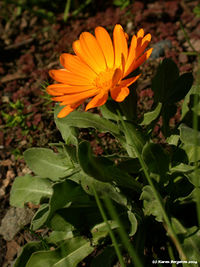Calendula officinalis
From Health Facts
(Redirected from Calendula)
Latest Edit: Hector 2014-03-18 (EDT)
| See Also | Botanical Monographs |
|---|
Calendula is commonly used topically to treat a range of skin conditions. To explore the characteristics, medicinal uses and prescribing considerations of this herb in more detail, check out the references indicated. [1], [2]
Contents
Characteristics
- Common Names: Marigold, Gold-bloom, Marybud, Pot marigold, Holigold, Calendula
- Family: Compositae/Asteraceae
- Habitat: Originally found along the north, east, and southeast Mediterranean Ocean coast, but is now naturalized in gardens around the world.
- Parts Used: Flower when fully opened, picked soon after opening (40% alcohol); the whole plant may also be used and squeezed into a succus (juice).
- Constituents: Flavonoids, volatile oils, terpenoids
- Medicinal Actions: vulnerary, antiseptic, antifungal, anti-inflammatory topically, anti-inflammatory gastrointestinal, antimicrobial
Uses
Medicinal Uses:
Topically
- Other Conditions
- Gingivitis, stomatitis, oral ulcers (gargle).
- Irritated nasal mucosa.
- Gonococcal leucorrhea (as a douche or rinse): irrigate an infusion of C. officinalis into the bladder via catheterization.
- Conjunctivitis (pinkeye): eyewash, poultice, compress of fresh flowers.
- Suppurative conditions with a lot of purulent discharge.
- Varicose veins.
Internal
- Digestive irritation (minor).
Prescribing Considerations
The information provided is intended to augment the treatment from a naturopathic doctor or other trained medical professional. Although most herbs are generally safe, it is recommended that you avoid self-prescribing especially when there is an underlying ongoing medical condition, if you are on any prescription medications or if you are pregnant or breastfeeding.
Formulations and Preparation
- Tincture - 30-60 drops three times daily
- Fluid extract - 10-40 drops
- Infusion - 1-4g flower (fresh or dried)/240mL of water; pour boiled water over and let steep covered for 10 minutes
- Poultice or compress from fresh plant/flowers
- Succus (juice in 10% alcohol) - good for skin wounds
- Ointment - 2-5g plant/100g ointment
Safety
The safety and prescribing considerations for Calendula include: [3], [4]
- Generally regarded as safe.
- Side-effect is possibly contact dermatitis
- Caution/Contraindicated in pregnancy and for people with allergies to plants in the Asteraceae/Compositae family
- Drug-Herb Interactions are not noted.
References
- ↑ Boon Heather, Smith Michael (2009) 55 Most Common Medicinal Herbs: The Complete Natural Medicine Guide Second Edition Institute of Naturopathic Education and Research, CCNM Toronto.
- ↑ Godfrey Anthony, Saunders Paul, Barlow Kerry, Gowan Matt (2011) Principles and Practices of Naturopathic Botanical Medicine, Advanced Botanical Medicine. V3 CCNM Press, Toronto.
- ↑ Stargrove Mitchell Bebell, Treasure Jonathan, McKee Dwight L (2008) Herb, Nutrient and Drug Interactions: Clinical Implications and Therapeutic Strategies
- ↑ Brinker Francis (1997) Herbal Contraindications and Drug Interactions: Plus Herbal Adjuncts With Medicines, 4th Edition Eclectic Medical Publications.
